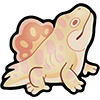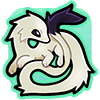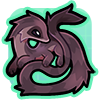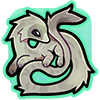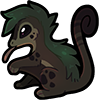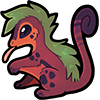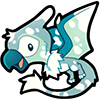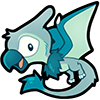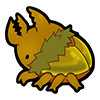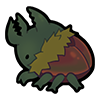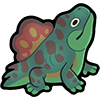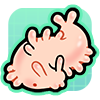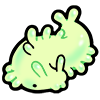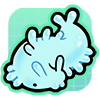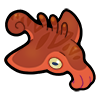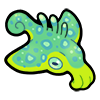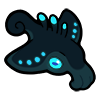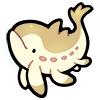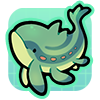Items
011 - Albino Ascadon
This large, amphibious animal spends much of its time in the shallows of rivers and other bodies of water throughout the rainforests of Kiah. A voracious predator, it will eat anything it can fit in its mouth, and its efficient digestive system renders it immune to poisonous prey. The sail on its back is collapsible, and mainly used for threat or mating displays.
Size: 6-10 ft / 1.8-3 m
Availability
Source:
Jungle Expedition 2022
020 - Leucistic Koronok
This noodly little vertebrate spends its days hiding in small crevices and hollows in the giant trees of Jurupa forest. Its many limbs have dexterous paws for grasping branches and its extremely long tail helps it stay balanced, even when navigating the narrowest of twigs. Koronok emerge at night to feast on the bountiful native mushrooms found throughout the forest.
Size: 20-25 in / 50-64 cm
019 - Timber Koronok
This noodly little vertebrate spends its days hiding in small crevices and hollows in the giant trees of Jurupa forest. Its many limbs have dexterous paws for grasping branches and its extremely long tail helps it stay balanced, even when navigating the narrowest of twigs. Koronok emerge at night to feast on the bountiful native mushrooms found throughout the forest.
Size: 20-25 in / 50-64 cm
018 - Silva Koronok
This noodly little vertebrate spends its days hiding in small crevices and hollows in the giant trees of Jurupa forest. Its many limbs have dexterous paws for grasping branches and its extremely long tail helps it stay balanced, even when navigating the narrowest of twigs. Koronok emerge at night to feast on the bountiful native mushrooms found throughout the forest.
Size: 20-25 in / 50-64 cm
017 - Melanistic Volan
This nocturnal vertebrate, known as a volan, is a proficient glider that makes its home among Kiah's dense canopies. Using its prehensile tail to rest safely during the day, its fur, containing special endosymbiotic plant cells, both camouflages it and provides energy via photosynthesis. At night, it glides between trees, seeking out night-blooming flowers that it feeds on the nectar from with its long tongue.
Size: 12-15 in / 30-38 cm
Availability
Source:
Jungle Expedition 2022
016 - Dusky Volan
This nocturnal vertebrate, known as a volan, is a proficient glider that makes its home among Kiah's dense canopies. Using its prehensile tail to rest safely during the day, its fur, containing special endosymbiotic plant cells, both camouflages it and provides energy via photosynthesis. At night, it glides between trees, seeking out night-blooming flowers that it feeds on the nectar from with its long tongue.
Size: 12-15 in / 30-38 cm
Availability
Source:
Jungle Expedition 2022
Purchaseable At:
015 - Piebald Teropita
This social avian can be found in the canopies in the Nuii region of the Kiah rainforests, where it feeds on fruit and nuts in large flocks. Its powerful bill can crack open even the most difficult nuts and rinds. The teropita's long tail makes an excellent rudder during flight, and the claws on its wings are used to grip and climb through branches to reach its food. Unfortunately, the Nuiian teropita has been difficult to find, and may be critically endangered.
Size: 20-30 in / 50-76 cm
Availability
Source:
Jungle Expedition 2022
014 - Nuiian Teropita
This social avian can be found in the canopies in the Nuii region of the Kiah rainforests, where it feeds on fruit and nuts in large flocks. Its powerful bill can crack open even the most difficult nuts and rinds. The teropita's long tail makes an excellent rudder during flight, and the claws on its wings are used to grip and climb through branches to reach its food. Unfortunately, the Nuiian teropita has been difficult to find, and may be critically endangered.
Size: 20-30 in / 50-76 cm
Availability
Source:
Jungle Expedition 2022
Purchaseable At:
013 - Leucistic Beeble
The beebles and other insectoids of the Kiah rainforests are practically innumerable, but unique among them is the dyno beeble; it has formed a symbiotic relationship with a species of moss which grows on its thorax. The beeble provides a safe, moist environment for the moss to grow, keeping it free of predation, and the moss provides the beeble with excellent camouflage on the forest floor. Although this insect has a fearsome appearance, it is truly slow moving and gentle, feeding on leaf litter and other detritus.
Size: 2-3 in / 5-7 cm
Availability
Source:
Jungle Expedition 2022
012 - Dyno Beeble
The beebles and other insectoids of the Kiah rainforests are practically innumerable, but unique among them is the dyno beeble; it has formed a symbiotic relationship with a species of moss which grows on its thorax. The beeble provides a safe, moist environment for the moss to grow, keeping it free of predation, and the moss provides the beeble with excellent camouflage on the forest floor. Although this insect has a fearsome appearance, it is truly slow moving and gentle, feeding on leaf litter and other detritus.
Size: 2-3 in / 5-7 cm
Availability
Source:
Jungle Expedition 2022
Purchaseable At:
001 - Common Kogii
This small animal feeds entirely on holoplankton, taking in huge gulps of water and expelling it through their dorsal branchia. This process filters out their prey and allows them to easily feed without inhibiting their respiration. They tend to be fairly docile, and are highly social with other kogii.
Size: 12-15 in / 30-38 cm
Availability
Purchaseable At:
010 - River Ascadon
This large, amphibious animal spends much of its time in the shallows of rivers and other bodies of water throughout the rainforests of Kiah. A voracious predator, it will eat anything it can fit in its mouth, and its efficient digestive system renders it immune to poisonous prey. The sail on its back is collapsible, and mainly used for threat or mating displays.
Size: 6-10 ft / 1.8-3 m
Availability
Source:
Jungle Expedition 2022
Purchaseable At:
009 - Albino Boolew
These hardy slugs spend their time scouring the ocean floor for their preferred benthic food: algae and other microscopic plant material! Slow moving, they make up for it by producing an incredibly sticky mucus from the antennae-like structures located across its body, allowing the boolew to escape most confrontations with predators.
Size: 3-8 in / 7-20 cm
008 - Reef Boolew
These hardy slugs spend their time scouring the ocean floor for their preferred benthic food: algae and other microscopic plant material! Slow moving, they make up for it by producing an incredibly sticky mucus from the antennae-like structures located across its body, allowing the boolew to escape most confrontations with predators.
Size: 3-8 in / 7-20 cm
Availability
Purchaseable At:
007 - Coastal Boolew
These hardy slugs spend their time scouring the ocean floor for their preferred benthic food: algae and other microscopic plant material! Slow moving, they make up for it by producing an incredibly sticky mucus from the antennae-like structures located across its body, allowing the boolew to escape most confrontations with predators.
Size: 3-8 in / 7-20 cm
Availability
Purchaseable At:
006 - Eastern Red Alona
Highly cooperative, the alona is an intelligent invertebrate. Both its tail and front tentacles are extremely dexterous; the rear one is used to grasp vegetation to remain anchored for sleeping or ambush hunting, and the front tentacles operate as grasping appendages, but also as sensory organs capable of detecting electromagnetic fields.
Size: 20-30 in / 50-76 cm
Availability
Purchaseable At:
005 - Blue-Spotted Alona
Highly cooperative, the alona is an intelligent invertebrate. Both its tail and front tentacles are extremely dexterous; the rear one is used to grasp vegetation to remain anchored for sleeping or ambush hunting, and the front tentacles operate as grasping appendages, but also as sensory organs capable of detecting electromagnetic fields.
Size: 20-30 in / 50-76 cm
Availability
Purchaseable At:
004 - Abyss Alona
Highly cooperative, the alona is an intelligent invertebrate. Both its tail and front tentacles are extremely dexterous; the rear one is used to grasp vegetation to remain anchored for sleeping or ambush hunting, and the front tentacles operate as grasping appendages, but also as sensory organs capable of detecting electromagnetic fields.
Size: 20-30 in / 50-76 cm
003 - Leucistic Kogii
This small animal feeds entirely on holoplankton, taking in huge gulps of water and expelling it through their dorsal branchia. This process filters out their prey and allows them to easily feed without inhibiting their respiration. They tend to be fairly docile, and are highly social with other kogii.
Size: 12-15 in / 30-38 cm
002 - Banded Kogii
This small animal feeds entirely on holoplankton, taking in huge gulps of water and expelling it through their dorsal branchia. This process filters out their prey and allows them to easily feed without inhibiting their respiration. They tend to be fairly docile, and are highly social with other kogii.
Size: 12-15 in / 30-38 cm
Availability
Purchaseable At:
